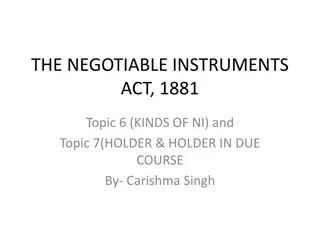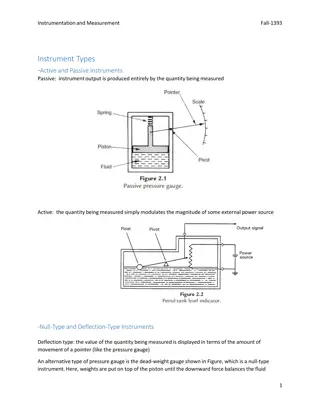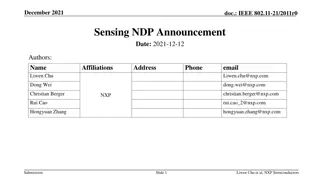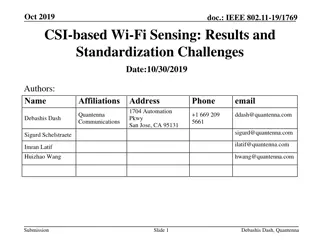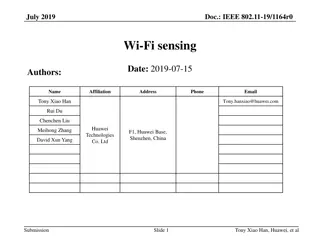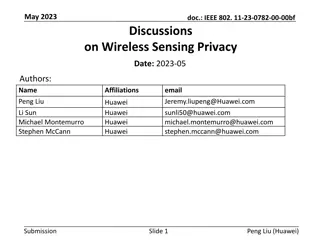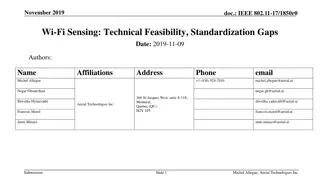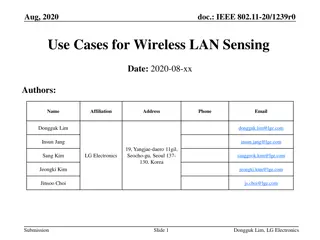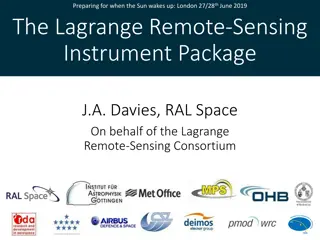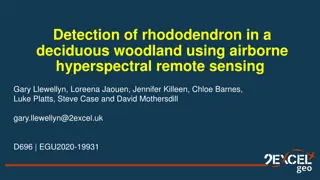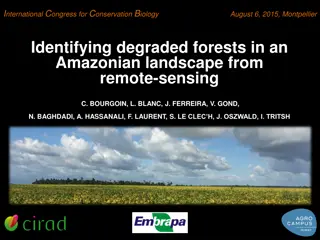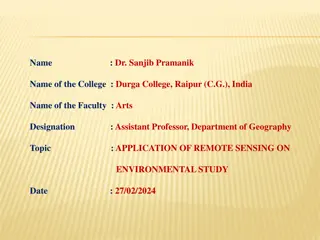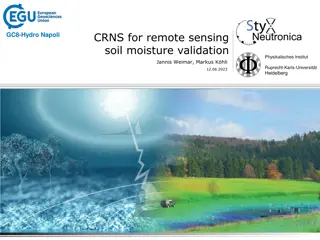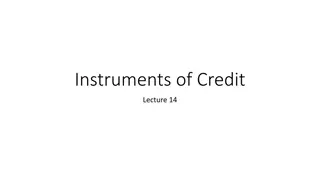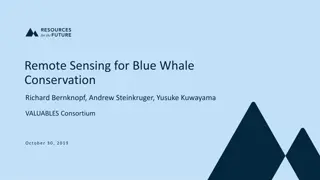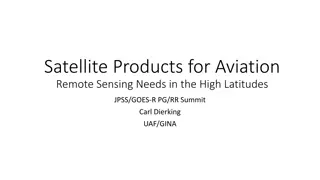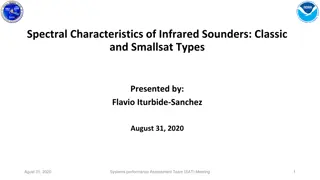Spectral and Radiometric Considerations for Government Remote Sensing Instruments
This presentation explores the important considerations in designing and calibrating government passive optical remote sensing instruments, focusing on spectral and radiometric aspects. Topics include spectral variation, design considerations, uniformity, reflectance calibration, and examples from instruments like Landsat-8. Detailed discussions on spectral variation, knowledge component integration, and spectral uniformity are provided, emphasizing the importance of precise control for accurate remote sensing data collection.
Download Presentation

Please find below an Image/Link to download the presentation.
The content on the website is provided AS IS for your information and personal use only. It may not be sold, licensed, or shared on other websites without obtaining consent from the author. Download presentation by click this link. If you encounter any issues during the download, it is possible that the publisher has removed the file from their server.
E N D
Presentation Transcript
Spectral and Radiometric Considerations for Spectral and Radiometric Considerations for Government Passive Optical Remote Sensing Government Passive Optical Remote Sensing Instruments: Design and Pre Instruments: Design and Pre- -Launch Characterization and Calibration Characterization and Calibration Launch Presenter: Brian Markham, NASA/GSFC Material from instrument and Cal/Val teams
Topics Spectral Considerations Variation Design considerations Knowledge Component versus integrated instrument Improved characterization techniques Radiometric Considerations Uniformity Reflectance versus radiance calibration Will be providing examples based on Landsat-8 instruments
Spectral Considerations Variation across Field of View Design considerations Knowledge Component versus integrated instrument Improved characterization techniques
Spectral Considerations (1) Spectral Variation across Field of View Control versus knowledge Is knowledge sufficient? Required uncertainty? science/application question Example pushbroom multispectral radiometer (nominally OLI on Landsat-8/9; similarly for MSI on Sentinel 2a and 2b) Approach - tight requirements on uniformity (overall, including spectral component for two targets for OLI) Drove design to nearly telecentric telescope (< 4 AOI variation on OLI) Tight control on filter variation (14 filter sticks required per band on OLI; [12 on MSI]) MSI VNIR Focal Plane OLI Focal Plane
Example - OLI Band 4 (Red) Spectral Uniformity All filter strips cut from same wafer (not true for most OLI bands) Measured range of about 0.6 nm between edge FPM s Lower Band Edge and center FPM s Edge FPM s band edge shifted to shorter wavelength Measured range of about 0.4 nm between edge FPM s Upper Band Edge and center FPM s Edge FPM s band edge shifted to shorter wavelength Shift approximately consistent with a 4 AOI difference Effect is to produce a limb brightening in vegetated scenes and a limb darkening in soil scenes (or at least our simulations of them)
FPM 1, 13, 14 FPM 8
Landsat OLI Spectral Response Uncertainties (within-band variability) Maximum Discontinuity Average Discontinuity Vegetation (%) Soil 0.12 RMS Variability Band Vegetation (%) Soil (%) Vegetation (%) Soil (%) CA 0.19 0.08 0.05 0.09 0.04 Blue 0.16 0.03 0.05 0.01 0.07 0.02 Green 0.11 0.02 0.05 0.01 0.07 0.01 Red 0.15 0.05 0.06 0.01 0.09 0.02 NIR 0.11 0.02 0.05 0.01 0.04 0.01 SWIR1 0.16 0.03 0.10 0.08 0.09 0.01 SWIR2 0.07 0.35 0.03 0.08 0.03 0.08 Pan 0.19 0.05 0.08 0.02 0.05 0.02
Spectral Considerations (2) Spectral Knowledge Component versus integrated instrument Product of components ~= integrated instrument Precision of measurements (Landsat OLI) Circa 1% in band Circa 1e-04 out of band (at FPA level) New techniques Tunable laser-based spectral test sets Allow full aperture, near full field illumination Adjacent bands and focal plane modules illuminated More light - higher precision Absolute calibration sub 1%
Component versus integrated instrument (in-band measurement) L8 TIRS Spectral Response Band 10 Average 1 Though more precise, component level measurements do not capture all effects 0.8 Relative response Interactions between detectors and filter angular effects can be complicated and difficult to model 0.6 0.4 TIRS instrument level response shifted from component level predictions: appears to be due to angular dependency of QWIPS response (more sensitive at larger angles and filter transmission different at larger angles) 0.2 0 9.8 10.3 10.8 11.3 11.8 Wavelength [ m] Simple Component Roll-up Instrument TVAC Reference: TIRS-2 calibration team (McCorkel et al)
Component versus integrated instrument (OOB measurement) Though more precise, component level measurements do not capture all effects FPM Level measurements capture within FPM Crosstalk, though not between. Flood source Testing does not distinguish in-field from out-of-field Response Instrument level OOB testing (not done on OLI), Planned for OLI-2 using tunable laser based system.
GLAMR Glamour Shots OLAF (OPO Laser Alignment Framework) -1 pump laser with tunable optical parametric oscillator (OPO) produces selectable wavelength light. Feeds integrating sphere via fiber optics. Integrating sphere with monochromatic light and NIST - calibrated transfer radiometers L9 MCDR 04/17 - 04/20/2018 FF Contains ITAR / EAR Sensitive Material For NASA Internal Use Only 13
Spectral Response Contributions to Radiometric Uncertainty (Landsat OLI example) Use of band-average RSR Filters well matched; generally small effect 0.1% Uncertainty in RSR Differences in integrated radiances between component and instrument level RSRs give a measure of uncertainty; generally 0.5% or less Out-of-band contribution Integrated OOB (beyond 1% response) typically 0.5% or less of in-band for solar spectra (except Cirrus) Crosstalk (out-of-field) contribution minor; except in Cirrus where there is often no in-band signal
Radiometric Considerations Uniformity across Field of View (flat fielding) Reflectance versus radiance calibration
Radiometric Considerations (1) Uniformity across Field of View (a.k.a., flat fielding) Landsat OLI Requirements (includes spectral contribution) 0.5% (1 sigma) across full field of view No stripes (single detector) exceeding 0.5% No steps exceeding 0.5% (at FPM boundaries) OLI Performance generally meets requirements based on pre-launch analyses Occasionally a few outlier detectors (mostly SWIR jumpers) On-orbit OLI performance at TOA appears to meet requirements, but non- uniformity is amplified in surface reflectance products, particularly water remote sensing reflectance
Landsat-8 OLI Cross Track Uniformity by Comparison at TOA to MODIS and VIIRS (Pahlevan et al., 2017) 1.06 MODIS (469) MODIS (488) VIIRS (486) MODIS (443) VIIRS (443) OLI(443) OLI(482) 1.04 rt(OC) / rt(OLI) 1.02 1 0.98 0.96 1.06 MODIS (531) MODIS (547) MODIS (555) VIIRS (551) MODIS (645) MODIS (667) MODIS (678) VIIRS (671) OLI(561) OLI(655) 1.04 rt(OC) / rt(OLI) 1.02 1 0.98 0.96 1 2 3 4 5 6 7 FPM 8 9 10 11 12 13 14 1 2 3 4 5 6 7 FPM 8 9 10 11 12 13 14 Uniformity generally meets requirements ( 0.5% 1 sigma) at TOA.
Landsat-8 OLI Cross Track Uniformity by Comparison to MODIS and VIIRS in Remote Sensing Reflectance* (Pahlevan et al., 2017) MODIS (469) MODIS (488) VIIRS (486) MODIS (443) VIIRS (443) OLI(443) OLI(482) 1.6 1.4 Rrs(OC) / Rrs(OLI) 1.2 1 0.8 0.6 0.4 MODIS (531) MODIS (547) MODIS (555) VIIRS (551) MODIS (645) MODIS (667) MODIS (678) VIIRS (671) OLI(561) OLI(655) 1.6 1.4 Rrs(OC) / Rrs(OLI) 1.2 1 0.8 0.6 0.4 1 2 3 4 5 6 7 FPM 8 9 10 11 12 13 14 1 2 3 4 5 6 7 FPM 8 9 10 11 12 13 14 At surface, in terms of remote sensing reflectance, variability is closer to 5% (1 sigma) *spectral radiance upwelling from beneath the ocean surface, normalized by the downwelling solar irradiance
Radiometric Considerations (2) Reflectance and Radiance Calibration All Landsat sensors from MSS on Landsat-1 to ETM+ on Landsat-7 had strictly a radiance based radiometric calibration provided (tied to NIST standard of spectral irradiance through FASCAL calibrated FEL lamp transferred to integrating sphere) Landsat-7 ETM+ had a diffuser, though reflectance-based calibration was not provided as part of data product (it could have been, but the diffuser was not well characterized in the SWIR bands) Landsat-8 OLI had both a radiance and a reflectance based calibration (ref cal tied to NIST through STARR calibrated reference diffuser) Both provided to users, each separately traceable to standards Similar to MODIS, though MODIS radiance was tied to reflectance call through a solar irradiance model Landsat-9 OLI-2 will be similar to Landsat-8 OLI (both calibrations provided) Current preference appears to be reflectance-based calibration due to lower uncertainty
Landsat OLI Radiometric Characterization/contributors to uncertainty Stability Responsivity stability between solar calibrations Dark level stability between shutter collects Linearity Less well characterized than intended; radiance linearity testing uncertainty dominated by sphere radiance uncertainty in non-controlled bands in radiance feedback mode (more in-band controlled levels to be used for Landsat-9 OLI-2 calibration) Relied on reciprocity, using integration time tests where radiance linearity testing was missing Imperfect understanding of reciprocity Uniformity Requirement was 0.5% (1 sigma) across full field of view (FFOV) (plus some more localized requirements) Extensive pre-launch analysis indicated FFOV requirement would be met Contributors include spectral, diffuser characterization residual, non-linearity correction residual, noise, dark current residual Stray Light Internal reflections in solar diffuser increase signal by ~1% based on modeling; testing results consistent, though with significant error bars
OLI Reflectance Calibration: Methodology, Traceability and Uncertainty Ball GD Etc. NIST U of A On-Orbit Sun (2) (2) (4) (1) (3) (3) (5) Xfer Panel Xfer Panel U of A Facility Flight Panels Flight Panels Flight Panels Earth Scenes STARR OLI Legend NIST Traceability (no move) NIST Traceability (w/move) Illumination Location Radiometer Source Diffuser Reflectometer (4) Calibration Process Step From Ball Aerospace Document
~5% reflectance change across OLI 15 FOV
Landsat-8 OLI Reflectance Calibration Uncertainty Estimates: Radiances of Ltypical and above (pre-launch evaluation) Value Term CA 1.4% 0.9% 0.7% 0.7% 0% 1.0% 1.0% 0.3% 0.1% 2.1% Blue 1.3% 0.9% 0.7% 0.7% 0% 1.0% 1.0% 0.2% 0.1% 2.0% Green 1.1% 0.9% 0.7% 0.7% 0% 1.0% 1.0% 0.3% 0.1% 1.9% Red 1.0% 0.9% 0.7% 0.7% 0% 1.0% 1.0% 0.3% 0.0% 1.8% NIR 1.0% 0.9% 0.7% 0.7% 0% 1.0% 1.0% 0.3% 0.0% 1.8% SWIR1 1.7% 0.9% 0.7% 0.7% 0% 1.0% 1.0% 0.3% 0.3% 2.3% SWIR2 1.4% 0.9% 0.7% 0.7% 0% 1.0% 1.0% 0.4% 0.2% 2.1% Pan 1.1% 0.9% 0.7% 0.7% 0% 1.0% 1.0% 0.3% 0.1% 1.9% Cirrus 1.7% 0.9% 0.7% 0.7% 0% 1.0% 1.0% 0.3% 0.6% 2.4% Initial Diffuser BRDF Geom Unc Diffuser Light Shade Stray Light Stray Light Pristine -> Wkg Wkg -> Scene Non-Linearity FFOV Non-Uniformity Long Term Stability 1s s Total Unc. Slightly modified from Ball Aerospace document
Government/Commercial Possible Synergies Transfer of NIST/NASA laser based calibration techniques (and other national labs) COTS tunable lasers available (e.g., used by GLAMR in SWIR)
Summary Current Landsat systems designed to provide spectral uniformity across the field of view circa 0.1% (1 sigma) contribution to radiometric error Near telecentric designs Tight filter uniformity requirements Current spectral response characterizations sub 1% uncertainty Radiometric variation across FOV circa 0.5% (1 sigma) Radiometric calibration uncertainty circa 2% (1 sigma)




